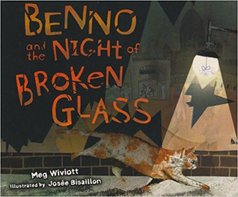Picture Book Portrayals of the Holocaust
 This Monday, April 24, is “Yom HaShoa V’Hagevurah,” the “Day of Remembrance of the Holocaust and the Heroism,” celebrated throughout the world to commemorate the six million Jews and all who perished at the hands of the Nazis. With the addition of the expression of heroism, the Israeli Knesset enacted the full name in 1953 to focus on the bravery of those who stood up to tyranny, Jews and non-Jews alike.
This Monday, April 24, is “Yom HaShoa V’Hagevurah,” the “Day of Remembrance of the Holocaust and the Heroism,” celebrated throughout the world to commemorate the six million Jews and all who perished at the hands of the Nazis. With the addition of the expression of heroism, the Israeli Knesset enacted the full name in 1953 to focus on the bravery of those who stood up to tyranny, Jews and non-Jews alike.
Each year (and perhaps this year especially), we are reminded that Holocaust education is essential. The question is: How do we explain the horrors of the Holocaust to young children? Picture books can be an excellent portal to open the door to discussion on this difficult topic.
Last month, I taught a class called “Picture Book Portrayals of the Holocaust” to a group of students at Ma’ayanot, the high school where I work. The class was part of a Book Day commemorating the life and legacy of humanitarian, author, professor and Nobel Laureate Elie Wiesel (1928-2016). Wiesel taught us: “We must always take sides. Neutrality helps the oppressor, never the victim. Silence encourages the tormentor, never the tormented.”
Following are beautifully illustrated picture books that highlight this essential message—a message for all ages:
 “The Terrible Things: An Allegory of the Holocaust,” by Eve Bunting, Illustrated by Stephen Gammell (Harper & Row, 1989)
“The Terrible Things: An Allegory of the Holocaust,” by Eve Bunting, Illustrated by Stephen Gammell (Harper & Row, 1989)
Summary: Animals of the forest are content until The Terrible Things arrive and blot out the sun. First they come for all feathered animals. Little Rabbit wonders what’s wrong with feathers, but the other animals silence him. “Just be glad it wasn’t us they wanted,” says Big Rabbit. Then the Terrible Things return for bushy tailed creatures, followed by every creature who swims, and so on. No one stands up to the Terrible Things until the forest is decimated.
The Takeaway: Through the inaction of the forest creatures, children can start to understand this horrible period of history and begin discussions of what each of us can do to prevent it from happening again. Eve Bunting’s allegory of the forest creatures may be less terrifying for children and can be extended to lessons against tyranny in today’s world.
 “The Whispering Town,” by Jennifer Elvgren, Illustrated by Fabio Santomauro (Lerner Publishing, 2014)
“The Whispering Town,” by Jennifer Elvgren, Illustrated by Fabio Santomauro (Lerner Publishing, 2014)
Summary: Based on a true story, this beautiful book shows how one family in Denmark protected Jews from the Nazis by hiding them in their cellar. Worried about their safety, the Danish daughter, Anett, comes up with a clever plan to get the Jewish family safely to the harbor.
The Takeaway: This book’s positive message shows how effective resistance can be. Even young children can accomplish amazing things. As we read in the author’s note, Danes bravely hid Jews in warehouses, barns, hotels, and churches. They hired boats to smuggle them safely to Sweden. About 1,700 Jews escaped from the small fishing village of Gilleleje during the war.
 “The Cats in Krasinksi Square,” by Karen Hesse, Illustrated by Wendy Watson (Scholastic Press, 2004)
“The Cats in Krasinksi Square,” by Karen Hesse, Illustrated by Wendy Watson (Scholastic Press, 2004)
Summary: Also based on a true story, this book shows how two sisters outfox the Nazis by using stray cats to distract their vicious dogs. The sisters then smuggle food to their starving friends in the Warsaw Ghetto.
The Takeaway: In one word: Resist! Hesse’s beautiful storytelling reminds us that each person has unique gifts and ingenuity to help others.
 “Benno and the Night of Broken Glass,” by Meg Wiviott, Illustrated by Jose Bisaillon (Kar-Ben Publishing, 2010)
“Benno and the Night of Broken Glass,” by Meg Wiviott, Illustrated by Jose Bisaillon (Kar-Ben Publishing, 2010)
Summary: With a cat’s-eye view, this book tells the fictional story of several families in one neighborhood in Berlin before, during, and after Kristallnacht (the Night of Broken Glass). An afterward shows photographs and tells about the real events of this horrific pogrom, which marked the beginning of the Holocaust on November 9, 1938. Wiviott’s gripping story and Bisaillon’s stunning illustrations show how normal life unraveled into horrific violence. Germans, who were once friends, lowered their eyes and turned their backs on their Jewish neighbors.
The Takeaway: This book poignantly portrays the disastrous results of a community’s inaction. By using a cat as a neutral bystander, children can watch events unfold and gain perspective and compassion for the victims. Nazis are portrayed by their brown shirts and black boots. As Wiviott—and Elie Wiesel— remind us, we cannot afford to remain neutral when our neighbors are being oppressed.
Other recommended picture books about the Holocaust:
“The Butterfly,” by Patricia Polacco (Philomel, 2000)
“Erika’s Story,” by Ruth Vander Zee and Roberto Innoncenti (Creative Editions, 2003)
“The Harmonica,” by Tony Johnston, Illustrated by Ron Mazellan (Charlesbridge, 2004)
What other picture books do you recommend with the message of not being silent and taking action? How can these lessons be extended for children? Please comment and share.

